- I would like to begin by asking you, Muhammad Abe, about the Indonesia Dramatic Reading Festival (IDRF), which you have been involved in since its inaugural holding in 2010. We would like to know what led to the start of the IDRF and what its original purpose was. I have heard that the playwright Joned Suryatmoko was involved in the launching of the IDRF.
- Yes. Correct. IDRF started in 2010. The idea came up in the Asian Playwrights Meeting held in Tokyo in 2009 at Za Koenji (co-organized by The Japan Foundation). For that Meeting a total of six playwrights were invited from countries like Singapore, the Philippines, Vietnam, Australia, and Joned participated as the playwright from Indonesia.
From there came the idea that this kind of platform could be applied to Indonesia, where at that time there was a steady decrease in the number of new plays appearing. In Indonesian theater, mostly they were performing plays from 1950s, 1960s, and 1970s, and not many new plays are being circulated. Because there is no platform for new plays, the next thing is that by doing reading of new plays, we could introduce new works to Indonesian theater practitioners. So, Joned took this idea to two people from the theater arts collective Teater Garasi in Yogyakarta, namely Gunawan Maryanto (*), who is a famous Indonesian theater and movie actor, director and writer, and Lusia Neti Cahyani, Teater Garasi’s program manager. It was these three; Teater Garasi members Gunawan and Lusia, and Joned, the director of the Teater Gardanalla, who got together with their organizations collaborating to launch the Indonesia Dramatic Reading Festival in Yogyakarta.
In 2010, at the initial festival, one of the artists invited was Yoji Sakate from Japan, and that was the first festival where one of his plays was read in Yogyakarta. Also, if I’m not mistaken, he was president of the Japanese Playwright Association at that time. So, it was quite an honor for us to have him in the first Indonesian Dramatic Reading Festival. From 2010 to 2020, for 10 years we organized IDRF every year. We have been introducing not only Indonesian plays, but also foreign plays that we translated into Bahasa. Because we thought that foreign plays have new things to offer, new ways of writing, new perspectives on writing that were not found in Indonesian plays, we wanted to introduce this kind of play to catalyze the development of playwrighting in Indonesia. In the first festival in 2010, I was involved as a translator, at that time I translated Doc Resureccion of Layeta Bucoy, one of the plays from the Philippines. - May I ask you how you found such new plays for IDRF, ones from and outside of Indonesia?
- To find plays from outside of Indonesia, Joned used the network he acquired at the Asian Playwrights Meeting in Tokyo. From there, he knew playwrights from the Philippines, Malaysia and Singapore, and he searched from there and asked if he could present the plays he found in translation into Indonesian at our festival. As for plays from Indonesia, at that time, Teater Garasi and Teater Gardanalla had been running programs for playwrights to write new plays. At the beginning, it was expected that the participants of the program could provide us with their plays for IDRF. But also, at that time, Lontar Foundation had a collection of plays from the 1910s and 1920s. So, we also included these plays in the program to remind people that Indonesia has a long tradition of playwriting.
- Indonesia is a large country made up of many islands with diverse ethnic groups and language. If you speak about Indonesia, are you referring mainly to the island of Java, or are referring to all parts of the country?
- Mostly we have been programming works of playwrights from Java and Sumatra. But recently, we are introducing plays by playwrights from other parts of Indonesia, such as Sulawesi and the east of Indonesia. In the past, works from these other regions were not circulated nationwide, but recently they have become known all over the country.
- IDRF 2019 was organized as the Asian Playwrights Meeting and was held in July with the cooperation of the grant program of the Japan Foundation Asia Center. I was able to participate in this meeting, which was very well curated. Would you please tell us about how the idea arose to organize the APM 2019?
- At first, it was Joned who talked about this idea of holding an Asian Playwrights Meeting in 2019. In the end of 2018, Joned, Gunawan, Lusia and I were thinking about planning something as a retrospective for the 10th year of IDRF. It’s also important to remember that the idea of launching IDRF first came from Joned after he attended the Asian Playwrights Meeting in Tokyo. So, we talked about the possibility to pitch this idea to have an Asian Playwrights Meeting in Yogyakarta to the Japan Foundation.
Since Joned had gotten an Asian Cultural Council grant to go to New York, I took over the responsibilities of organizing the 2019 APM in Yogyakarta. I think it was my first time organizing an international event. To help me out, he introduced me to the playwright Alfian Sa’at (https://asiawa.jpf.go.jp/en/culture/features/asiahundred09/) from Singapore. Alfian already had a large network of theater people in Asia. His play Nadirah had been read in IDRF in 2013. Alfian came from Singapore to Yogyakarta to meet with me. Today, with COVID-19 travel like that is difficult, but at that time, it was just a 2-hour flight. Alfian also came to IDRF 2018. Alfian informed me about BIPAM, the Bangkok International Performing Arts Meeting, and asked me to come to BIPAM in 2018. I went to Bangkok in November and participated in BIPAM, and I think that is also the first time I met you, wasn’t it? - You came to Japan to take part in the Next Generation: Producing Performing Arts program organized by the Japan Foundation Asia Center to coincide with TPAM 2019 (Performing Arts Meeting in Yokohama 2019).
- That was my first time coming to Japan, and I remember when I landed there it was snowing [laughs]. TPAM was also important for me because there I was able to get to know people from many regions in Asia, from Cambodia, Vietnam and India, and I also had a chance to meet several young Japanese playwrights and directors.
I also met Suguru Yamamoto there, who we then invited to our APM 2019. I was also able to meet Jun Tsutsui and to see the work of Yuri Yamada. I found that the theater scene in Japan was quite interesting, with a lot of different styles, a lot of theatrical language, and a lot of experimenting with new language and with artistic expression. I think attending TPAM is a great chance for me, and it helped a lot in organizing APM in 2019. One performance I still remember the performance was in a small apartment. It was a very strong performance by a young theater group (The Demolished Woman performed by the company “ofuton” in the TPAM Fringe program. I also saw a lecture performance by Yudai Kamisato titled A Haphazard Stranger’s Rough Report (With a side of Asado Beef and Onigiri). They served some delicious food too [laughs]. I was able to see many performances in a short period, including Irwan Ahmed’s Constellation of Violence from Indonesia. - So, then you started to curate a program for APM 2019 after you returned to Indonesia from TPAM. How did you select the works for the program?
- We wanted to invite people from different regions. At the time we were thinking about selecting six to eight playwrights, from Malaysia, Singapore, from the Philippines and from Japan, of course. Alfian has more knowledge about the theater scenes in Singapore and Malaysia and also Thailand, so we picked some names from that region. And because of my experience at TPAM, where I met Japanese playwrights and directors, I picked some names from Japan as well. The other ones from the Philippines and Cambodia, we searched for through the network that I found at BIPAM. Also, since there were some performing arts professionals from the Philippines participating in the Next Generation: Producing Performing Arts program, I also had them introduce some playwrights to me. I also got people from a Cambodian arts organization that I met at TPAM to give me the names of some Cambodian playwrights.
- Unfortunately, my schedule didn’t allow me to visit the drama readings on the first day of APM 2019 by Ridwan Saidi of Malaysia and by Suguru Yamamoto of Japan. I heard that the reading of Suguru’s work Yojo X (Girl X) performed by Yogyakarta’s arts collective Ace House Collective was very well received. I saw the reading of the work Taxi Radio by the Thai playwright Nophand Boonyai and since it was a story about radio, it was performed by radio announcers from a radio station in Yogyakarta. I appreciated the way you paired each work with interesting performers, which I thought was a great form of creation.
- From the very beginning of our Indonesia Dramatic Reading Festival (IDRF) we have worked to bring in people from outside the theater world. They are not actors, but we ask them to perform in IDRF. For example, every year we used to invite visual artists to perform in the readings of the plays. At that time, I thought it would be interesting to have Suguru’s play be presented by Ace House Collective which is a young visual artists collective, and I think they perform it quite interestingly. Because they perform the reading without any emotion, without any expression, perhaps Suguru was surprised to see his play Yojo X be presented in a monotone way without a lot of expression.
I think that we can be surprised by the way people who are not actors present a play, because they can interpret it in very different ways. Suguru’s work is very experimental because some of the characters are presented only in the form of text. How he used text as a tool of dramaturgy is very interesting. Also, in Yojo X I see Suguru using technology in his play as an important tool. The way technology was used in a performance as one of props or a part of dramaturgy, that may be very Japanese. Of course, Japanese people may have different opinions. It’s also interesting that he presents the woman character only through text.
As for Taxi Radio, I thought from the beginning that it would be interesting to have it performed by radio announcers. There are some people that we knew, who were radio announcers, and we invited them to perform the play reading. I think that was also interesting because the sound, the way they talk, is very much like a radio announcer. The playwright, Nophand, who doesn’t know Bahasa Indonesia, was able to follow all the emotion and the rhythm. I think that’s what’s interesting in drama reading and in theater, because it goes beyond the language. - Can you tell us about some of the other playwrights whose works were presented?
- The Singaporean playwright Jean Tay presented her play Plunge, which was very interesting, because she writes it from her experience as an economic journalist at that time in 1997, 1998 when she was following the collapse of the Asian economy. So, it’s very detailed in describing how the fall of the macroeconomy, the world economy, connected to the small narrative of the Indonesian-Chinese minority.
How to connect these two issues? It’s very interesting. Also, her perspective is different from other plays about the 1998 Asian economic crisis. And I think that the play is still relevant even today, because not many people talk about this issue anymore even though the issue has not been solved. So, I thought it would be interesting to put it in APM to make people remember about what happened at that time, because maybe in the future, it can happen again. We don’t know. We must remember to make people not forget that this thing happened before.
There were other plays like Red Janger by Ibed Surgana Yuga from Indonesia. This play also talked about an unresolved issue. Ibed is from Bali. He writes differently about Bali, known globally as a “Paradise Island.” He writes about the misery of the Balinese people in 1965. And also, he connects the tragic 1965 issue with the development of tourism and people forgetting about what happened in the past.
One of the plays was very long. It was Necrotopia by Ridhwan Saidi from Malaysia. The play is also experimental and speaks about a dystopia community and totalitarian society. The characters are humans and humanoids. A dictator has the power to make changes in the community. I think it is a basic story that Southeast Asians have a lot of experience with.
From Cambodia there was Chea Sokyou’s play Courageous Turtle and from the Philippines was Maria Christina Pangan’s play Last Requirement. I think Chea Sokyou’s play Courageous Turtle is similar to Ibed’s work about memory of the past, about the violence in the past. And Maria Christina Pangan’s play Last Requirement is mainly about the relation between a father and daughter, but also the background of the story is about the conflict between a mining company and local inhabitants. This is an issue that has happened in Indonesia as well, and also in other Asian regions.
So, the collection of works in the program of APM 2019 were chosen based on representation of the different areas of the region, and through them we could see some things in common and shared themes. Some tell stories about the past, some tell stories about the future, and also about the technology of the play itself, how they use the narrative to tell their story. - I thought it was a very good combination of works. I was also impressed by how seriously involved the audience was. Quite a lot of the audience was young people, and many were university students.
- We have lots of universities in Yogyakarta. We call it a student city here. Maybe, they are involved in such things on their campuses, so they want to know about theater. Most of the audiences are students. And also, there are senior theater people in the audiences who are interested in new plays.
- And also, I was very impressed by the number of professionals from beyond the borders of theater, music or the visual arts, who were all supporting APM in very collaborative and cooperative ways. There seemed to be a very good infrastructure for artistic activities.
- Yes. Because we have a lot of artists in Yogyakarta, a lot of community artist collectives in Yogyakarta, and we support each other. And because Yogyakarta is a small city, lots of people know each other. Our circles are connected somehow, so it’s easy to know people from another circle, and also, they are willing to help. And it’s easy to get from one point to another in such a small city.
Muhammad Abe
Spreading from Indonesia into Asia,
a Platform for Theater and Playwriting
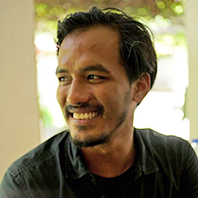
Muhammad Abe
Curator of Asian Playwrights Meeting (APM)
Inspired by the Asian Playwrights Meeting held in Tokyo in 2009, the following year the Indonesia Dramatic Reading Festival (IDRF) was established in Yogyakarta, Indonesia and was held annually for ten years. For the 10th anniversary of the IDRF in 2019, an Asian Playwrights Meeting (APM) 2019 with playwrights invited from Japan and countries of Southeast Asia.
Interviewer: Makiko Yamaguchi
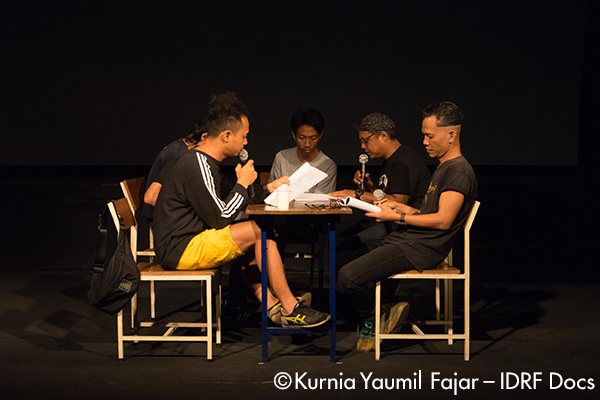
Reading of Girl X written by Suguru Yamamoto, performed by Ace House Collective in APM 2019
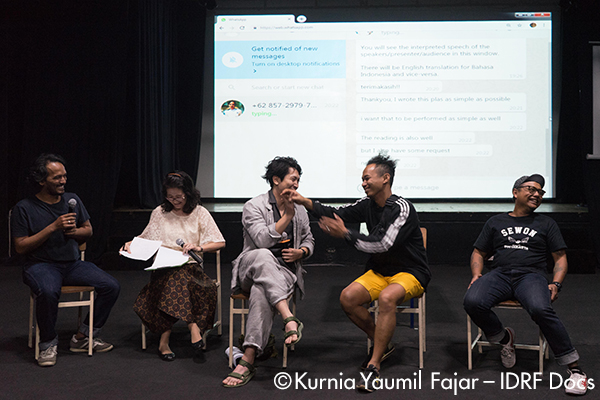
Discussion after Ace House Collective performed reading of Girl X by Suguru Yamamoto in APM 2019
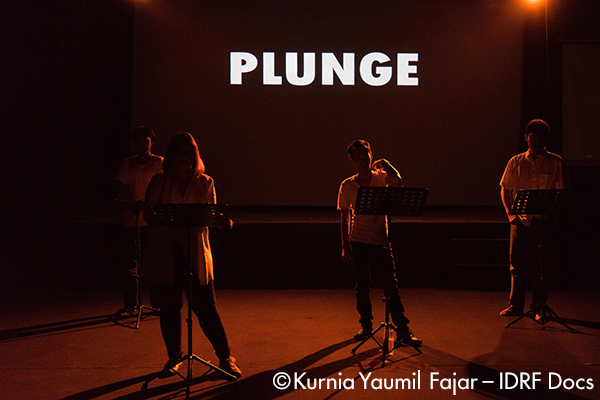
Reading of Plunge written by Jean Tay, performed by Irfanuddien Ghozali’s team in APM 2019
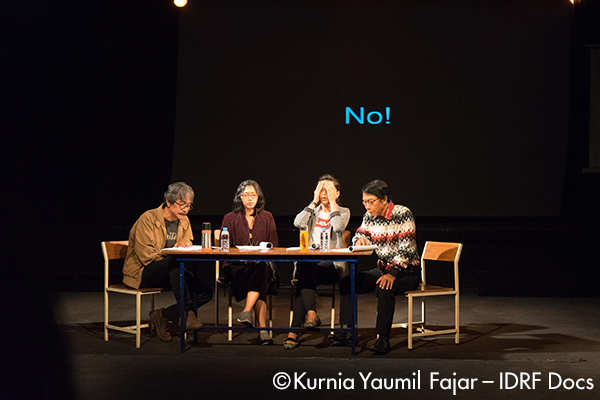
Reading of Taxi Radio written by Nophand Boonyai, performed by radio announcers from Yogyakarta in APM 2019
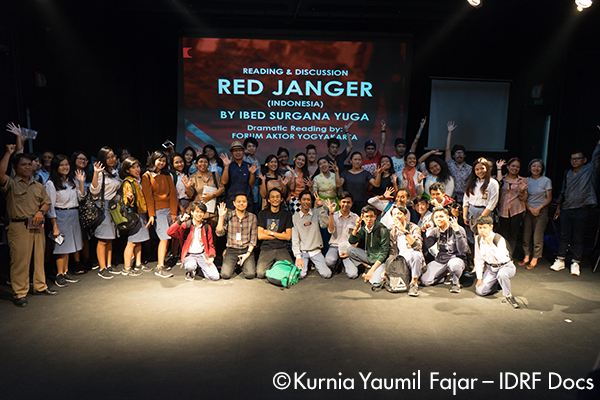
All the playwrights and APM 2019 team and guests doing a photo together after reading of Red Janger written by Ibed Surgana Yuga performed by Forum Aktor Yogyakarta
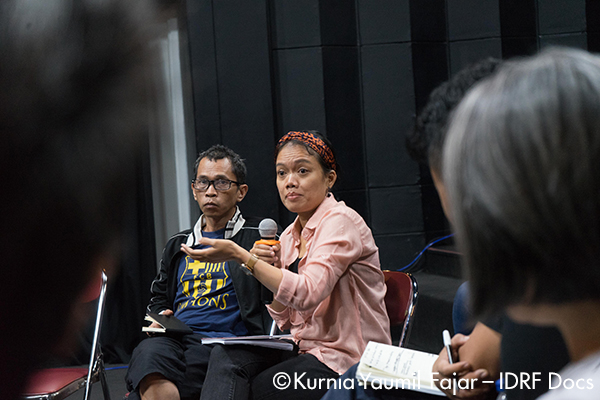
Gunawan Maryanto (left) together with Shinta Febriany curator of APM 2019 in one of the discussion session
- Every day at APM 2019, there were themed discussions held every morning. And for one of them the theme was translation, as people involved in the translations of the six works in the readings, yourself and Teguh Hari appeared as speakers. You are originally an actor and Hari is originally a director, but you both served as translators as well.
- Because I’m also an actor, I imagine how it will be spoken on the stage. I think about how the rhythm and sounds of the translated text should relate to the drama. I give importance to these things as I translate, and sometimes if we have difficulties to translate from English to Bahasa Indonesia to get the rhythm or to get the sound, we go to the unique local language. For me, it’s Javanese. Because we think that our local language has more richness in terms of expression and, a lot of ways of expressing one thing. It’s more, how to say, sweet, than the national language, which is more formal.
- So, there are some difficulties in translating from English to Bahasa Indonesian language, aren’t there?
- Yes, it is not easy, but I think if we get connected to the plays, when we get the ideas behind the plays, then we get interested. For example, I translate plays like Jean Tay’s play Plunge from Singapore, which I found to be very interesting. Because it tells a story about Indonesia. It presented different ways to see the situation behind events in Indonesia in 1998, of history for us, because it’s written by someone outside, and they may have a different perspective on it.
- For APM 2019, you invited not just the playwrights of the works selected but also some observers, and Aya Ogawa from New York, who is a translator.
- Yes. I think because we don’t want it only to talk about artistic direction of plays or talk about the plays only, but also to talk more widely about the development of a play and also translation issues, as well as disparity in the theater scenes in Asia. Because until now, it may still be difficult to find playwrights from places like Vietnam, Cambodia and Myanmar, compared to finding playwrights from Malaysia, Singapore or Indonesia or Japan, where there are more new plays being published. I think as a platform Asian Playwrights Meeting wants to talk also about Asian societies and to talk in greater depth about issues that we face today.
Aya Ogawa is a translator of theater works who has a lot of experience, and she knows not only a lot about Japanese plays, but also about theater in the US. At that time, we had participants in the discussions such as Ugoran Prasad, who is a dramaturg of Teater Garasi, and we also invited Jarunun Phantachat (https://asiawa.jpf.go.jp/en/culture/features/f-ah-tpam2019-jarunun-phantachat/) from Bangkok. She is someone who shares the same interest and spirit as us about theater as a platform. I think both IDRF and APM have wanted to use the events as a platform for possibly developing plays, developing theater, and for talking about anything.
In addition to the role of APM as an international platform for playwrights from Asia, we also feel it is important to connect to the local theater community here where we are based and to connect to the experience and knowledge that has been accumulated here. Unless we can do that, we are only looking up at the sky and we can’t see the ground that we actually stand on. So, on the final day of the event in order to reflect on the significance, we asked the senior local poet and playwright, Ikun Sri Kuncoro to participate, and that turned out to be a very important thing. He has known me since I was at university, and locally he is famous for his network with many artists from the senior to the younger generations. - In that session, Suguru Yamamoto said that theater plays are something like a tool to meet people, and when people come together and meet in such ways it can give birth to changes in society. I have the feeling that his experiences being a part of your APM and meeting playwrights through it was very motivational and empowering for him. Do you think that drama readings have significant potential for international exchange and understanding?
- Yes, I think drama readings are more compact than full theater productions. It is easier to travel across borders with drama scripts than with full stage performances, and it is the same within Indonesia because we have a huge country with its many islands. A play reading enables diverse exchanges. However, we also wish that the plays being read will someday be performed in full scale on stage. It’s not IDRF’s or APM’s role to realize that. We hope that the artists may get the idea and take the initiative to do that. It could be a director from Thailand staging a play from Indonesia, or a director from Japan staging a play from Thailand or the Philippines. I think that as a form of exchange to get to know each other better, drama reading is quite an effective platform.
- It seems as if in this time of the coronavirus pandemic, when it is difficult to travel and to have people gather together in close proximity, the potential of play readings is being rediscovered.
- Yes. In the pandemic situation like this people don’t have a chance to go to theaters and see full stage performances. But, drama readings online are possible. It’s expensive and requires a lot of technology to realize full stage performances. Probably, theater people don’t understand that well enough, but I am sure that drama readings provide an easier way to deliver plays to the public.
- There can be unexpected new discoveries for the playwrights themselves. And even though you might say it is just a reading, there is still a considerable amount of directing that goes into it, as we saw from the variety of performances to be seen at your APM event.
- Yes, I think that’s the beauty of drama readings. In Yogyakarta there are a lot of creative people like actors. Thanks to their long support of our IDRF events, we are able to present new plays every year in a variety of different styles.
- By the way, although she has not been invited to your APM event, I know that you presented Satoko Ichihara’s play The Question of Faeries at your IDRF 2018.
- I knew Satoko from the Jejak Tabi exchange in Yogyakarta curated by Helly Minarti (dance researcher) (https://asiawa.jpf.go.jp/en/culture/features/asiahundred03/) and Akane Nakamura. The first Jejak Tabi exchange was held in Yogyakarta, which Satoko was invited to. She presented her works, and we were especially interested in The Question of Faeries for IDRF 2018. Unfortunately, Satoko could not come to Yogyakarta at that time, so it was only her play being read by the young local theater collective Sakatoya. And after APM 2019, I invited Satoko to an event in Ho Chi Minh City in 2020. But, because of the Coronavirus, we didn’t get the chance to come to it. I still talked with Satoko, and just recently in June we did an online version of The Question of Faeries with Sakatoya.
- What do you think of Satoko’s work?
- I think Satoko’s play is very interesting. In Indonesia, in my experience, not many female playwrights use methodology or metaphors like Satoko does. I think The Question of Faeries is a very strong and good play that is easily accepted by different societies in Indonesia because her idea of the position of woman in the society is quite similar.
- Would you tell us something about your future plans for IDRF or APM?
- The 2020 IDRF had to be done online. And probably it will be the same in 2021. Online performances allow theater companies outside of Yogyakarta the chance to participate, which means there are new experiences and opportunities. Last year, the Teater Kala from Makassar on the island of Sulawesi was able to participate for the first time, along with one from Maumere in East Nusa Tenggara Timur and one from Solo on Java were also able to participate online.
We plan to hold this year’s IDRF in September, but the online-only performances will be in November. If possible, we want to do hybrid presentations, but we don’t know yet. And also, this year IDRF is collaborating with BIPAM. We have one program together where we will present plays that have been censored or banned in the past in Thailand, Singapore and Indonesia among other places (https://www.bipam.org/bipam2021-showcases). And, although it is still in the planning stage, next year we may be able to hold an APM in Japan. And we will also be publishing a book of the plays presented in APM 2019. - By the way, we hear that you also published a collection of English translations of Indonesian plays in London.
- Yes, the Indonesian government has a lot of programs and we were lucky to be involved in one of the programs that enabled us to introduce new Indonesian plays in the London Book Fair. One of the publishers in London was interested in publishing English translations of Indonesian plays, so we were able to have a collection titled “New Indonesian Plays” be published.
- Finally, would you to tell us a bit about yourself personally.
- Yes, I think I didn’t know about theater until university, because before that I was mostly doing sports. Actually, I was thinking about becoming an athlete, in basketball, but I changed my mind when I was in university. I began studying history in university, and then I got interested in theater, because I thought that theater would help me not to be as shy in public. And then from there, I just got more and more into theater. I got to know the theater scene, I got to know Teater Garasi, then I met Joned at Teater Gardanalla. In Yogyakarta there are lots of different festivals every year where I could see performances, both from Indonesia and from abroad. The Yogyakarta art scene helped shape my vision of the arts and theater. But also, in the last few years, my involvement attending BIPAM and TPAM also opened my eyes, or my mind about artworks, because before I was only seeing artworks from Indonesia. And now I have built up a network with people in Asia’s theater world.
- I hear that you are also active in art collectives, aren’t you? Including Gymnastik Emporium and the Indonesia Conference of Theatre and Performance.
- Yes, I am active in Gymnastik Emporium and the Indonesia Conference of Theatre and Performance. Gymnastik Emporium is my collective together with Irfanuddien Ghozali, who was the director of Plunge by Jean Tay from Singapore in APM 2019. The other members are Abdi Karya, a performer from Makassar who is now living in Yogyakarta, Ari Dwianto, Kurnia Yaumil Fajar and Vandy Rizaldy. We are a collective of people from different genres: theater, dance and visual arts. The idea of Gymnastik Emporium is to combine sport with art. Especially how gymnastics is used by the government to shape our body and our mind, our vision and how it also separated the ideal body and the non-ideal body.
We performed for the first time at the Jakarta Biennale in 2020, and then with an online performance for the Indonesian Dance Festival that year, where our performance was a result of a workshop with gymnastics teachers from Yogyakarta, and we had them talk about how the movement of gymnastics has developed and how it develops our shared experience. Our performance was based on the results of that workshop. We had this national gymnastic project in the New Order era, from the 1970s to mid-1990s. In it, every Friday we had to do the movement throughout all of Indonesia. We wanted to trace back to the National Gymnastic Movement and to re-interpret the national gymnastics into today’s context where people have more freedom. People now have more freedom to express themselves. Gymnastik Emporium is a combination between strict guidelines, how to do the movement and also we invite people to freely interpret the movement as to their body. If they want to follow the quite guide, it’s okay. We are still developing it. We hope that we have a chance to perform again in the future. - The other collective you are involved in is the Indonesia Conference of Theatre and Performance. What is the conference focused on?
- This conference is a platform to create a space where researchers and academics in the performing arts can meet with the artists involved in theater and performance, or artists of any discipline. The inaugural conference was held last year and conducted online. We call it a conference, but it is not a typical academic conference, because we felt a need to establish a platform where artists can present themselves, their work or their research, or their ideas as artists. I think it’s still developing. I feel we are still looking for the right format to do this in Indonesia. And since we did it online, a lot of artists from outside of Java were able to be involved. A lot of audience also participated, and there were interesting talks and discussions from the panels and from the presentations. We plan to hold the next conference in September of 2021.
- In Indonesia there are many active artist collectives. And now there are also international activities, like Documenta that takes place every five years in Kassel, Germany, which has drawn attention to the fact the Indonesian collective Ruangrupa will serve as artistic directors for the next exhibition.
- I think in my case, it is mostly organic, because I get to know people then we work together. Like my collective, I have known the people since long time ago. We can fit the idea and say, “Let’s go work together.” So, I don’t have to be doing all of the things involved, and instead we share our burden, not structurally, but we share our work. I will say, “I will do this.” Or, “I can’t do that.” Will you do the choreography for me? Or we say, “Let’s find the resources together.” I think it’s strategic to be in a collective compared to if I do something myself. There are many different working methods for collectives in Indonesia. I think one of the unique aspects in Indonesia is that the artists tend to work in collectives, especially in performing arts.
- Finally, we would like to ask you what your perspective is on the performing arts after the coronavirus pandemic.
- I think in the last year or year and a half, I have learned that we must have a backup plan. Also, I have learned that we have the possibility of doing hybrid performances, or performances that combine online and offline elements. In this case, we have an on-site performance for a limited audience but also do streaming online. I think this is also a trend in Indonesia right now, to have hybrid performances. For theater people, for performing arts people, this is a new thing involving new experiences. Because before they only knew performance that was live on the stage, and video was only for documentation. I think technology has a language of its own, so it depends on how you use it. With a performance on stage, the audience cannot zoom in on the performer, but with video, we can zoom in and change perspective. We can arrange how the audience can see and follow the performance. I think this is technology that we have learned about in the last one and a half years. I don’t know, but maybe in the future, live performance and online performance will have a similar degree of importance.
During the pandemic, I have also learned that the situation is difficult. I have come to believe that simplicity is the important thing, in terms of what we can do to still be creative in this time of limited resources and limited performance spaces. The situation is now challenging for us, with lot of limitations and restrictions, but creativity must be used to find answers to deal with these limitations. We must ask how we can use the limitations as tools, as our power.
With the online format, the interesting point is that we can be connected. Like with this interview, I can talk with you and your colleagues without having to fly to Japan, or without you having to come to Indonesia. So, this is one of the advantages. As for IDRF, with the online format we can involve many more groups around the country, so the festival will be distributed more widely. Because in Indonesia, if you go to another island from Yogyakarta, it will be more expensive than for me to go from Yogyakarta to Singapore.
On the other hand, there are things that the online format cannot resolve, such as the distance between us. Because, without meeting people in person we cannot bring the real oneness. With online methods we miss the once-in-a-lifetime experience of meeting people in person. For exchanges like APM it is important to be in one place and share the same time, so that we can build those kinds of experiences. For IDRF itself and for APM, we hope that we can have live meetings sometime next year after the pandemic situation is better. - I also hope very much that that will happen. Thank you very much for your precious time to have this interview on Zoom due to the coronavirus pandemic.
- Indonesia Dramatic Reading Festival – Asian Playwrights Meeting 2019
https://asiawa.jpf.go.jp/en/culture/events/?business%5B%5D=culture_wa2
https://apm2019.home.blog/
Efforts as a Platform
The Potential of Drama Readings
Looking to the Future
From Theater to Art Collectives
*Obituary about Gunawan Maryanto:
It grieves us to report that Gunawan Maryanto suddenly passed away on the 6th of October, 2021. May he rest in peace.
Related Tags

